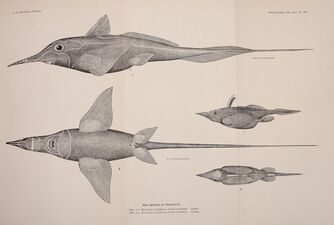Biology:Narrownose chimaera
| Narrownose chimaera | |
|---|---|

| |
| Scientific classification | |
| Domain: | Eukaryota |
| Kingdom: | Animalia |
| Phylum: | Chordata |
| Class: | Chondrichthyes |
| Subclass: | Holocephali |
| Order: | Chimaeriformes |
| Family: | Rhinochimaeridae |
| Genus: | Harriotta |
| Species: | H. raleighana
|
| Binomial name | |
| Harriotta raleighana Goode & T. H. Bean, 1895
| |
The narrownose chimaera (Harriotta raleighana) is a longnose chimaera of the family Rhinochimaeridae,[2] the longnose chimaeras, consisting of eight species belonging three genera.[3] This species is found in temperate seas worldwide, at depths between 200 and 3,100 m.[2] Its length is between 1.0 and 1.5 m, including a long, tapering snout and a long, filamentous tail.[4]
Taxonomy
This species was first described by George Brown Goode and Tarleton Hoffman Bean in 1895.[5] The genus Harriotta refers to Thomas Harriot and the species name references Sir Walter Raleigh.[2][6]
Description
Narrownose chimaeras have elongate rostra, slender tails, large pectoral and pelvic fins, large eyes, and two dorsal fins, the first being preceded by a mildly toxic spine.[3][6] They possess two pairs of non-replaceable tooth plates in the upper jaw and a one pair in the lower jaw.[7] Male H. raleighana are estimated to reach 62.8 cm (24.7 in) and female 75.8 cm (29.8 in) at maturity, respectively.[8]
Habitat
The narrownose chimaera is found off Nova Scotia and in much of the rest of the Atlantic Ocean,[9] and in parts of the Pacific Ocean to depths of 3100 metres.[3] Very little is known of their biology due to their deep water habitats.[7]
Reproduction
Longnose chimaeras are members of the class Chondrichthyes, diverging from their closest relatives (sharks, rays, and skates) approximately 400 million years ago.[10] Like many other Chondrichthyes, longnose chimaeras reproduce by laying eggs.[8] Egg cases consist of a central chamber surrounded by a web-like structure.[7] Female longnose chimaeras lay a pair of eggs several times per season.[10]
Conservation status
The IUCN has classified this species as being of least concern.[1] In June 2018 the New Zealand Department of Conservation classified the narrownose chimaera as "Not Threatened" under the New Zealand Threat Classification System.[11]
Gallery
References
- ↑ 1.0 1.1 Dagit, D.D.; Walls, R.H.L.; Buscher, E. (2016). "Harriotta raleighana". IUCN Red List of Threatened Species 2016: e.T60140A3088899. doi:10.2305/IUCN.UK.2016-1.RLTS.T60140A3088899.en. https://www.iucnredlist.org/species/60140/3088899. Retrieved 20 November 2021.
- ↑ 2.0 2.1 2.2 Froese, Rainer and Pauly, Daniel, eds. (2006). "Harriotta raleighana" in FishBase. April 2006 version.
- ↑ 3.0 3.1 3.2 "FAMILY Details for Rhinochimaeridae - Longnose chimaeras". http://www.fishbase.org/Summary/FamilySummary.php?Family=Rhinochimaeridae.
- ↑ Laura Gegel (2016-03-22). "Freaky winged fish with glowing green eyes mystifies fishermen". CBS News. http://www.cbsnews.com/news/freaky-winged-fish-with-glowing-green-eyes-mystifies-fishermen/.
- ↑ Goode, G. Brown; Bean, Tarleton H. (1895). "Scientific results of explorations by the U. S. Fish Commission steamer Albatross. No. XXX. On Harriotta, a new type of chimaeroid fish from the deeper waters of the northwestern Atlantic". Proceedings of the United States National Museum 17 (1014): 471–473. doi:10.5479/si.00963801.17-1014.471. https://biodiversitylibrary.org/page/15675494.
- ↑ 6.0 6.1 Goode, G.B.; Bean, T.H. (1895). "Scientific results of explorations by the US Fish Commission steamer Albatross. No. XXX. On Harriotta, a new type of chimaeroid fish from the deeper waters of the northwestern Atlantic". Proceedings of the United States National Museum 17: 471–473. doi:10.5479/si.00963801.17-1014.471. https://repository.si.edu/bitstream/handle/10088/13375/1/USNMP-17_1014_1895.pdf.
- ↑ 7.0 7.1 7.2 Didier, Dominique A. "Phylogeny and classification of extant Holocephali." Biology of sharks and their relatives 4 (2004): 115-138.
- ↑ 8.0 8.1 Finucci, B.; Dunn, M. R.; Jones, E. G.; Anderson, J. (2017-02-01). "Reproductive biology of the two deep-sea chimaerids, longnose spookfish (Harriotta raleighana) and Pacific spookfish (Rhinochimaera pacifica)" (in en). Deep Sea Research Part I: Oceanographic Research Papers 120: 76–87. doi:10.1016/j.dsr.2016.11.008. ISSN 0967-0637. Bibcode: 2017DSRI..120...76F. http://www.sciencedirect.com/science/article/pii/S0967063716301972.
- ↑ McMillan, Elizabeth (March 7, 2016). "Creepy deepwater fish surprises Nova Scotia fisherman". CBC News. https://www.cbc.ca/news/canada/nova-scotia/lunenburg-fisherman-photographs-creepy-deepwater-fish-1.3479154.
- ↑ 10.0 10.1 "Chimaera" (in en). 7 November 2018. https://www.sharktrust.org/chimaera.
- ↑ Duffy, Clinton A. J.; Francis, Malcolm; Dunn, M. R.; Finucci, Brit; Ford, Richard; Hitchmough, Rod; Rolfe, Jeremy (2018). Conservation status of New Zealand chondrichthyans (chimaeras, sharks and rays), 2016. Wellington, New Zealand: Department of Conservation. p. 10. ISBN 9781988514628. OCLC 1042901090. https://www.doc.govt.nz/globalassets/documents/science-and-technical/nztcs23entire.pdf.
Wikidata ☰ Q3066285 entry
 |




